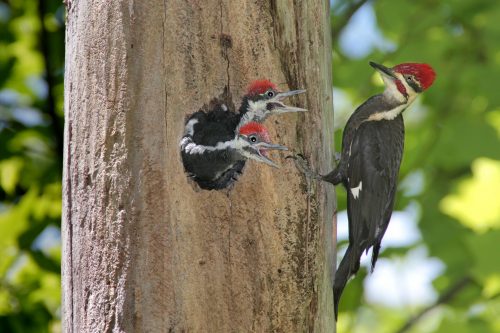IN THE NEIGHBORHOOD
Birds are a wonderful introduction to the natural world outside your door. Whether in the city or in a forest, a variety of birds are usually within easy eyeshot or earshot. Observing birds helps to instill an appreciation of wildlife and encourages empathy for all living things. Observing birds supports mental health and overall wellbeing. In addition, observing birds can also help learners of all ages understand how different components of nature work together to support living things.
 TIPS FOR FINDING BIRDS
TIPS FOR FINDING BIRDS
“Birding is a totally accessible activity,” says Rich Merritt, director of operations for Audubon New York, a nonprofit conservation organization that focuses on birds as well as other wildlife. To get started, simply step outside, and bring along a scientist’s most important tools—your eyes and ears.
- Explore where you are. Birds are wherever you are. You can watch birds from your window or listen to their calls when you first wake up in the morning. You can look for birds in trees along city sidewalks, on wires along highways, in gardens, on ponds and by rivers, in forests and wetlands, or at the beach.
- Be quiet. Birds are easily startled by noises and will head for cover if they hear you coming.
- Watch for movement. Stay still and watch for movement in trees, shrubs, or grass.
- Listen for bird songs and sounds. Many birds stay hidden, but if you keep an ear out, you can often hear them even if you don’t see them.
- Be patient. Finding birds often means waiting for the birds to show themselves.
- Make it a challenge. Neurodiverse learners – and others – often enjoy challenges like making lists. Create a challenge to find and list as many different bird species as possible or make your own list of 5-10 local bird species to try and find.
MEETING THE NEEDS OF DIVERSE LEARNERS
Birding can provide engaging and equitable learning experiences. Here are some ideas for making birding activities as accessible as possible.
- Choose an outdoor learning site that is accessible.
- Mark off boundaries with physical clues, such as flags or chalk marks.
- Show directions and desired actions using words, pictures, and concrete objects.
- Establish both verbal and nonverbal signals for calling the group together.
- Provide recording devices for children to log thoughts and observations.
- Put learners in pairs for explorations so they can help each other.
- Invite students to use all of their senses when making observations.
- Encourage mindfulness by noticing how birds can help create a sense of calm.
- Check out birdability.org for information about making birding more accessible to all.
EDUCATE FOR THE LOVE OF BIRDS
PLT and American Bird Conservancy (ABC) have collaborated to develop a special new digital activity collection–Together for Birds. The activities are designed for educators to use with students in Grades K-2, with variations for Grades 3-5. The collection is filled with bird-centric enrichment experiences, reading recommendations, forest facts, accompanying posters, and charts. Through this collection of activities, students will explore the birds and other organisms that live on or around your own unique setting.
JOIN THE CONVERSATION: WATCH THE WEBINAR
Discover hands-on resources that use birds to create fun, inclusive, and authentic learning experiences for everyone with a free educator webinar held by American Bird Conservancy, North American Association for Environmental Education, and Project Learning Tree. Together, we explored how to begin environmental investigations using birds to hone the practices of observation, discovery, and reflection. No prior birding experience required!
Webinar participants will be able to:
- ENGAGE learners in inclusive birding experiences.
- EXPERIENCE an elementary environmental education resource, Together for Birds, exploring how it can be used to introduce the concept of habitats through birds.
- PRACTICE reflection after experiencing the joy, wonder, and connection made possible by birds.
RECOGNIZE AND RESPECT BIRDS
Remember that birds play countless roles in healthy ecosystems—and improve our overall quality of life. Think about the last time you saw a bird. How might you add to the graphic below?




